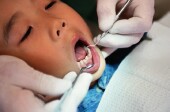
TUESDAY, Feb. 2 (HealthDay News) — Parents who make regular visits to the dentist are more likely to take their children to the dentist, a new study shows.
Using data from a recent National Health Interview Study on 6,107 children aged 2 to 17, and their parents, researchers found that 77 percent of children and 64 percent of parents had seen a dentist in the previous year.
Kids whose parents saw a dentist were more likely to have seen a dentist, too. About 86 percent of children whose parents had a dental visit during the preceding year had a dental exam, compared to about 63 percent of the children whose parents hadn’t, the study authors found.
With cavities in children on the rise, programs that encourage kids to take care of their teeth should also target their parents, said study author Dr. Inyang Isong, a pediatrician and research fellow at Massachusetts General Hospital Center for Child and Adolescent Health Policy.
“Strategies to promote oral health should focus on the whole family,” Isong said.
In the study, about 76 percent of the parents were employed, and the same number had health insurance. But even among those with health coverage, financial barriers kept some families out of the dentist’s chair, Isong said.
Among parents who delayed dental care because of cost, 27 percent of their children also had dental care deferred.
Tooth decay is one of the most common chronic diseases in the United States, especially among minority and lower-income kids, according to background information in the study released online Feb. 1 in advance of publication in the March print issue of Pediatrics.
Mary Hayes, a pediatric dentist in Chicago and a spokewoman for the American Dental Association, said the study reflects what she sees in practice.
“We know for so many different behaviors that children pick up on their parents,” Hayes said. “In order for good oral health in children to occur, parents need to value oral health as well.”
The American Dental Association recommends children have their first dental visit by their first birthday. Since many parents don’t think to take their partially toothless infant to the dentist, a move has developed in recent years to teach pediatricians and other non-dental health-care providers about preventive dental care, Hayes said.
State Medicaid programs, for example, have started paying physicians to apply topical fluoride treatments during well-child visits, according to a second study in the same journal by researchers at the University of North Carolina, Chapel Hill.
While about 70 percent of doctors taking part in a Medicaid demonstration project reported they provided preventive dental care on a routine basis, challenges in getting doctors on board included difficulty in applying the varnish, difficulty integrating dental care into the practice and resistance among staff, the researchers noted.
Hayes said having primary-care doctors more involved in preventive dental care is a good idea. For too long, oral health and the health of the rest of the body have been treated as separate concerns, when the condition of the teeth and the gums actually is an indication of overall health.
“I do believe we need to be getting pediatricians more aware of oral health issues,” Hayes said. “These projects are trying to figure out how to connect the disciplines of dentistry and medicine, and that makes sense for us all as patients.”
One hurdle, however, is that oral health care training in medical school is minimal, according to a third study in the same journal by researchers from Children’s Mercy Hospital and Clinics in Kansas City, Mo. Their study found that even Web-based training for pediatric residents could help them learn the skills to do a basic oral exam, though also getting hands-on treatment from a dentist is better.
More information
The American Academy of Family Physicians has more on oral health for children.

